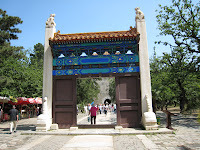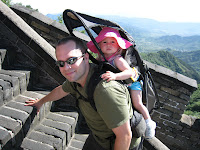The Great Wall of China
 Visiting the Great Wall of China was indeed the highlight of our trip. This brick, stone and earthen wall is a magnificent structure, which spans over 4,000 miles from Shanhai Pass in the east to Lop Nur in the west, along a winding arc that roughly outlines the southern edge of Inner Mongolia. It is also the largest human-made structure ever built in terms of surface area and mass. It was built, rebuilt and maintained between the 5th century BC and the 16th century to protect the northern borders of the Chinese Empire during the rule of successive dynasties.
Visiting the Great Wall of China was indeed the highlight of our trip. This brick, stone and earthen wall is a magnificent structure, which spans over 4,000 miles from Shanhai Pass in the east to Lop Nur in the west, along a winding arc that roughly outlines the southern edge of Inner Mongolia. It is also the largest human-made structure ever built in terms of surface area and mass. It was built, rebuilt and maintained between the 5th century BC and the 16th century to protect the northern borders of the Chinese Empire during the rule of successive dynasties. Several walls, referred to as the Great Wall of China, were built since the 5th century BC, the most famous being the one built between 220 BC and 200 BC by the first Emperor of China, Qin Shi Huang. That wall was much further north than the current wall, built during the Ming Dynasty, and little of it remains today.
Several walls, referred to as the Great Wall of China, were built since the 5th century BC, the most famous being the one built between 220 BC and 200 BC by the first Emperor of China, Qin Shi Huang. That wall was much further north than the current wall, built during the Ming Dynasty, and little of it remains today. 
We visited the Mutiyanu section of the Great Wall, about 1 hour North of Beijing. As we walked the Wall, there are some very steep sections and steep steps.
 The picture to the right shows us with our tour guide Martin. For those inquiring minds, he is standing on the highest point of the wall we were standing on.....but he is still much taller than both of us. So the answer to your question is, No....the Norwoods are not giants in China either! Martin told us he loved military movies and he was always dressed in some sort of military clothes with his dog tags. He also is a fan of Desperate Housewives...go figure!
The picture to the right shows us with our tour guide Martin. For those inquiring minds, he is standing on the highest point of the wall we were standing on.....but he is still much taller than both of us. So the answer to your question is, No....the Norwoods are not giants in China either! Martin told us he loved military movies and he was always dressed in some sort of military clothes with his dog tags. He also is a fan of Desperate Housewives...go figure! It's hard to imagine the Mongolian armies scaling these mountains to pillage China alone, but it is even harder to imagine them scaling the Great Wall with all of its full-time guards. But I guess during times of scarcity in the cold north, hunger can be a pretty big incentive. The picture to the left shows the small holes used by the guards to fire arrows at the oncoming Mongolians.
It's hard to imagine the Mongolian armies scaling these mountains to pillage China alone, but it is even harder to imagine them scaling the Great Wall with all of its full-time guards. But I guess during times of scarcity in the cold north, hunger can be a pretty big incentive. The picture to the left shows the small holes used by the guards to fire arrows at the oncoming Mongolians.
The picture on the right shows one of the holes where carrier pigeons were kept. These pigeons were used to send messages to the Chinese army. The guards also used warning fires and actually used feces of different animals to send messages coded by the particular smell. Martin told us that the entire army in Beijing could be ready to defend Beijing within 2 hours of receiving word of an oncoming attack.
You can also go up on the roof of some of the guard stations for the best views.


You take a gondola to reach the Great Wall. (On the way down, even Sydney noticed the scenery from the gondola and began pointing and saying, "Wow.")
The Great Wall of China was every bit the awe-inspiring, man-made, historical creation that we expected it to be. And the beautiful blue sky was the perfect natural backdrop.
The Ming Tombs (including The Sacred Way)
The Ming Tombs were listed as a UNESCO World Heritage Site in August 2003. They are the mausoleums of 13 emperors of the Ming Dynasty (1368 - 1644) and are located about 50 km north of Beijing. The site was chosen by the third Ming Dynasty emperor Yongle (1402 - 1424), who moved the capital of China from Nanjing to Beijing. He is credited with envisioning the layout of the ancient city of Beijing. After the construction of the Imperial Palace (the Forbidden City) in 1420, the Yongle Emperor selected his burial site and created his own mausoleum.
They are the mausoleums of 13 emperors of the Ming Dynasty (1368 - 1644) and are located about 50 km north of Beijing. The site was chosen by the third Ming Dynasty emperor Yongle (1402 - 1424), who moved the capital of China from Nanjing to Beijing. He is credited with envisioning the layout of the ancient city of Beijing. After the construction of the Imperial Palace (the Forbidden City) in 1420, the Yongle Emperor selected his burial site and created his own mausoleum.
 They are the mausoleums of 13 emperors of the Ming Dynasty (1368 - 1644) and are located about 50 km north of Beijing. The site was chosen by the third Ming Dynasty emperor Yongle (1402 - 1424), who moved the capital of China from Nanjing to Beijing. He is credited with envisioning the layout of the ancient city of Beijing. After the construction of the Imperial Palace (the Forbidden City) in 1420, the Yongle Emperor selected his burial site and created his own mausoleum.
They are the mausoleums of 13 emperors of the Ming Dynasty (1368 - 1644) and are located about 50 km north of Beijing. The site was chosen by the third Ming Dynasty emperor Yongle (1402 - 1424), who moved the capital of China from Nanjing to Beijing. He is credited with envisioning the layout of the ancient city of Beijing. After the construction of the Imperial Palace (the Forbidden City) in 1420, the Yongle Emperor selected his burial site and created his own mausoleum. From the Yongle Emperor onwards, 13 of 16 Ming Dynasty Emperors were buried in this area. The tombs of the first two Ming Emperors are located near Nanjing (the capital city during their reigns). Emperor Jingtai was also not buried here as the Emperor Tianshun had denied Jingtai an imperial burial but was instead buried west of Beijing.
From the Yongle Emperor onwards, 13 of 16 Ming Dynasty Emperors were buried in this area. The tombs of the first two Ming Emperors are located near Nanjing (the capital city during their reigns). Emperor Jingtai was also not buried here as the Emperor Tianshun had denied Jingtai an imperial burial but was instead buried west of Beijing.The site of the Ming Dynasty Imperial Tombs was carefully chosen according to Feng Shui(geomancy) principles. According to these, bad spirits and evil winds descending from the North must be deflected; therefore, an arc-shaped area at the foot of the Jundu Mountains north of Beijing was selected. This 40 square kilometer area - enclosed by the mountains in a pristine, quiet valley full of dark earth, tranquil water and other necessities as per Feng Shui - became the necropolis of the Ming Dynasty.

In front of the Ming Tombs, there is a walk called the "Sacred Way," leading the way to Heaven. The Emperor, known as the Son of the Heaven, who came from Heaven to his country through the Sacred Way, also would return to Heaven through this road. The road is lined with stone statues. At the end of the road, is a large statue of a turtle (symbol of longevity) holding a tablet with Chinese inscription. It is said if you touch the head and tail end of the turtle, you will have good luck. We figured it was worth a try.
The statues are 12 human figures (including the general, civil officials and meritorious officials) and 24 animals which are lion, camel, elephant, xiezhi (a mythological unicorn), qilin (one of the four "divine animals, the other three are dragon, phoenix and tortoise), and horse. There are 4 of each of these animals: two standing and two squatting with different meanings. It i s said that these animals change guard at midnight...
s said that these animals change guard at midnight...
 s said that these animals change guard at midnight...
s said that these animals change guard at midnight...
No time on this tour to stick around and find out...we were on to the next stop!




10 comments:
Those are some awesome pictures.
Looks like a great trip.
stop trying to kiss pepe. since you and your potty words were the reason this fine blog was banned in China.
Dude!
That picture of the whole Norwood clan on the Great Wall is totally (word edit) awesome.
I mean, gosh darn (no word edit needed here), last place I went was Framingham.
I mean, whats worse than that? Ohio?
You can always come and visit Dave, Japan is probably more interesting than Framingham.... unless of course you are a cardiologist. Then again you don't see many cardiologist tourists in Framingham, I guess they are too busy reading about Framingham. On that note, please come visit us...and that goes for everyone.
We're working on getting there.
This summer its all about getting the dog.
Next summer its all about getting to Japan.
Dave, not that I'll change your mind, but just letting you know you've got that all backwards...you should vacation first, then get a dog. Otherwise, you have to find someone to watch your dog, which TRUST ME, is a royal pain. But next summer is probably better for us anyway and you can meet Norwood #4!
Just bring the dog with you to Japan so Mitch will have someone to play with
all good thoughts...but no minds changed...no plans changed...
Since Dave and I can't travel to Japan for a while, we have decide to go to Oishii, a new Japanese restaurant, in your honor. It is suppose to be better than Fugakyu. It is not the real thing but the best we can manage here in Boston.
Oooo! Oooo! I know what that means! Oishi means delicious, so any restaurant with that name is sure to be good. (Brian says Fugakyu, Curtis. Just kidding. When do you move?)
BTW everyone, my sister's been visiting, so my China blogging has been on hold. But it will be continued shortly.
Post a Comment